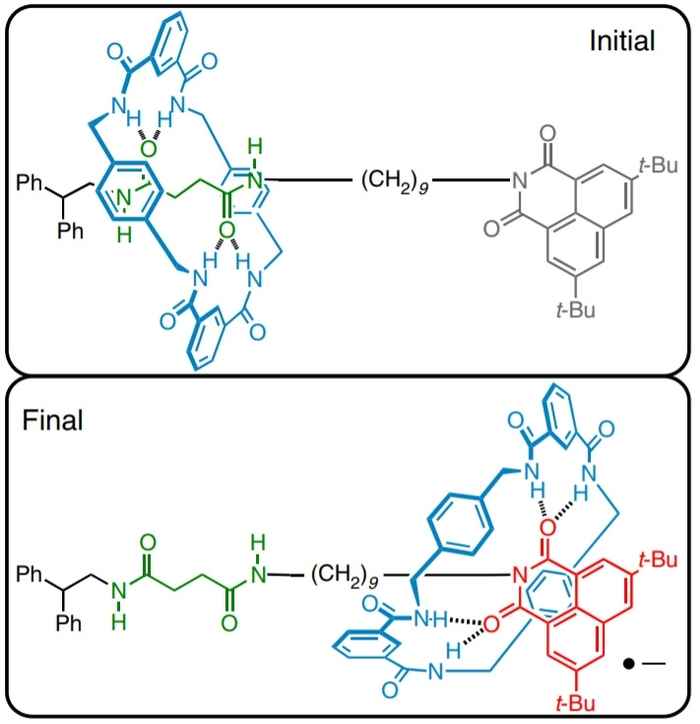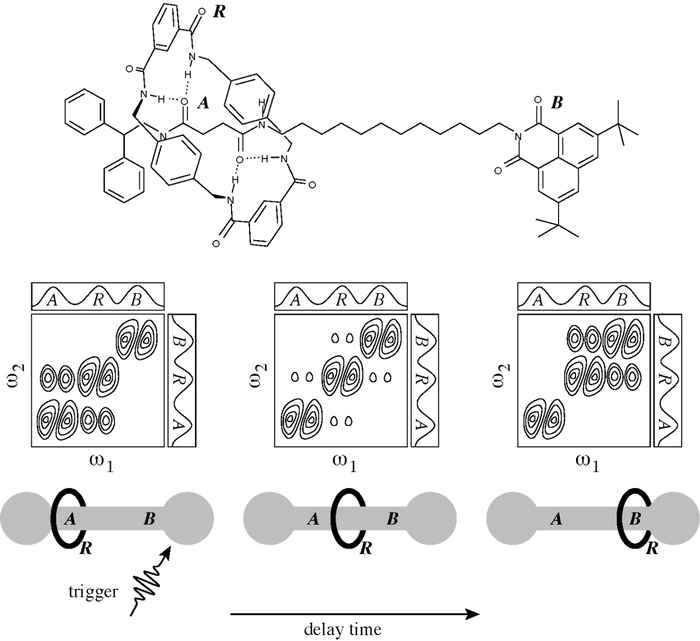Study reveals new details of molecular machine in motion
Transient two-dimensional infrared spectroscopy (T2DIR) enables direct observation of molecular machinery components at work
22 December 2017

The research published describes the combined efforts of the teams of HIMS professors Fred Brouwer, Wybren Jan Buma and Sander Woutersen. They cooperated with Prof. David Leigh of the University of Manchester. First author is Dr Matthijs Panman, who now is a postdoc researcher at the University of Götenborg.

The research concerns a 'molecular shuttle'; a rotaxane-based molecule where a macrocyclic ring moves back and forth along a molecular thread between two docking stations. By applying two-dimensional infrared (T2DIR) spectroscopy the researchers could observe directly how the components move with respect to each other, and how their spatial structure changes during this motion.
The unique T2DIR study indicates that the macrocyclic ring adopts a boat-like conformation at the final station as opposed to the chair-like conformation at the initial station. Probing the conformational changes of molecular machines during their operation in real time is essential for understanding their mechanics and optimizing their functionality.
Less than a picosecond
The couplings between vibrational modes of the motor molecule as determined by transient two-dimensional infrared (T2DIR) spectroscopy provides a means for directly probing the structural changes at the molecular level as these couplings are directly related to the relative orientation and distance of the coupled oscillators. A 2DIR spectrum therefore provides direct conformational information, similar to 2D-NMR spectroscopy, but with a time resolution of typically 1 picosecond, or less.
In time-resolved 2DIR spectroscopy, a conformational change is triggered and subsequently 2DIR spectra are recorded at specific time delays. By recording a series of 2DIR spectra at increasing time delays, a molecular movie of the conformational changes can be obtained.

The Amsterdam researchers report that the cross peaks in the T2DIR spectra of the molecular shuttle recorded at different stages of its operation cycle directly reveal the proximity of the shuttling macrocycle to the different stations on the thread. Furthermore, by interpreting the T2DIR spectra using quantum-chemical calculations, they present evidence that the macrocycle adopts two distinct conformations depending on the docking station to which it is hydrogen bonded.
Decomposing the T2DIR spectrum
Normally, it would have been a for all practical purposes impossible task to disentangle the T2DIR spectra of molecules of the size of the studied molecular machine. By introducing a novel method for decomposing the congested equilibrium- and transient-2DIR spectra the researchers were able to isolate the macrocycle/thread cross peaks in the T2DIR spectrum from other vibrational contributions. The method exploits the presence of the localized electronic chromophore in the investigated molecule. The researchers believe that their method can be useful in many other cases, especially when larger and more complex molecular systems will be investigated with 2DIR spectroscopy.
Article
Matthijs R. Panman, Chris N. van Dijk, Adriana Huerta-Viga, Hans J. Sanders, Bert H. Bakker, David A. Leigh, Albert M. Brouwer, Wybren Jan Buma & Sander Woutersen: Transient two-dimensional vibrational spectroscopy of an operating molecular machine. Nature Communications (2017) Published online 20 December 2017 DOI: 10.1038/s41467-017-02278-6